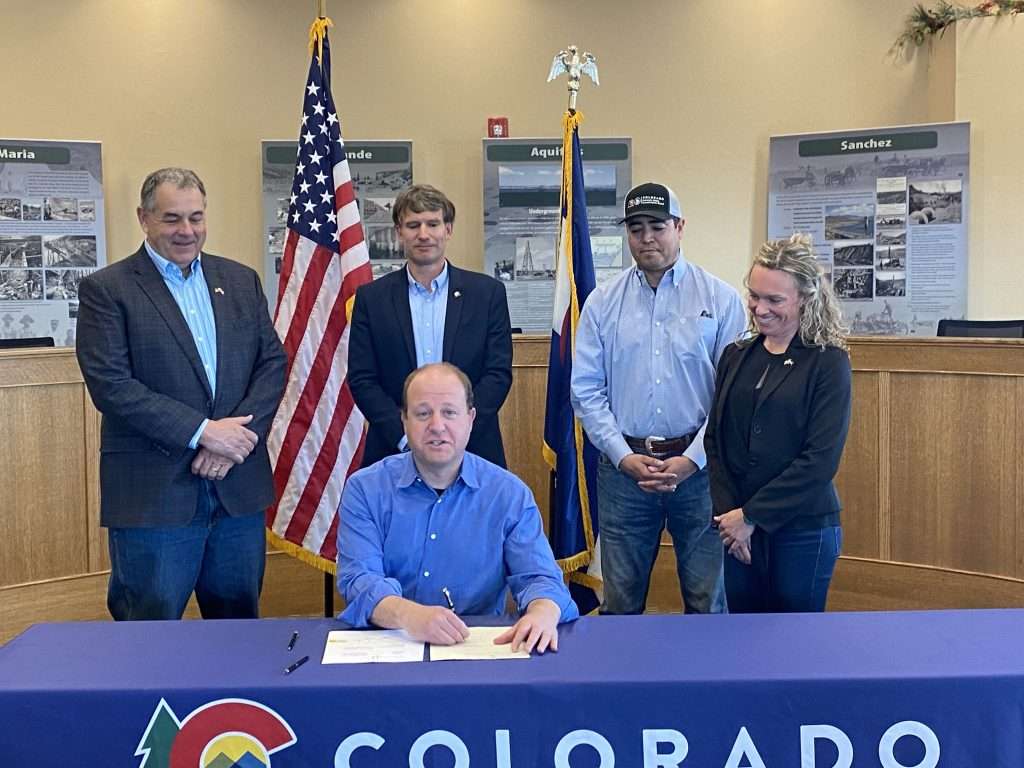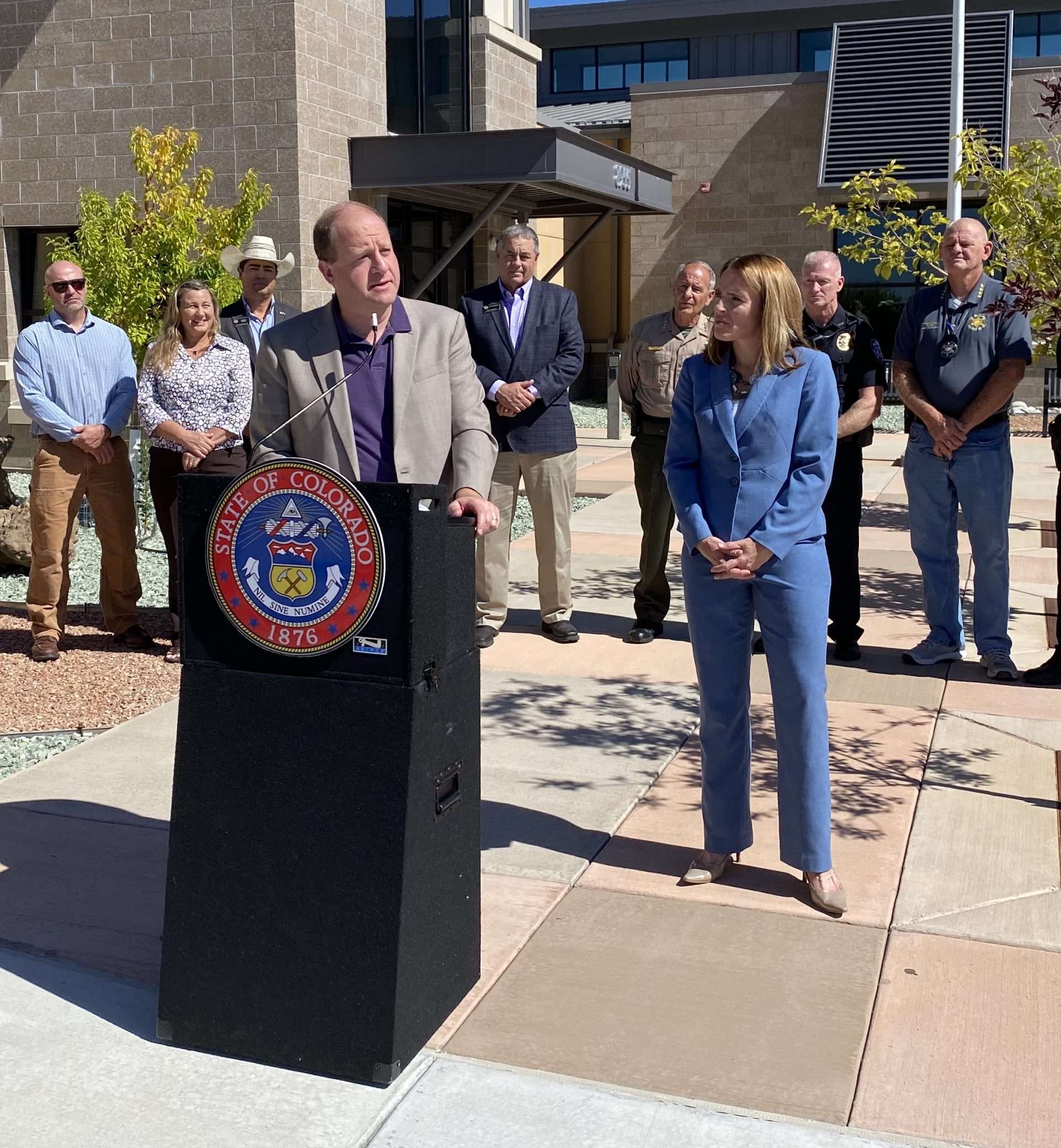Colorado Governor Jared Polis spoke to Crestone Eagle Editor John Waters in a wide-ranging interview on September 22 that included the proposal by Renewable Water Resources to export water from the San Luis Valley to Douglas County, the governor’s initiative, the Heat Beneath our Feet to increase energy production from geothermal sources, the possibilities of agrivoltaics in the San Luis Valley, the affects of decreased cannabis tax revenues and a possible bid for the White House in 2024.

Resources Executive Director Dan Gibbs, Colorado Representative Donald Valdez (D), and Agriculture Commissioner Kate Greenberg (D). Photo by John Waters
Polis began the interview by saying he is “super-excited” the Crestone Eagle is now a non-profit.
POLIS: Congrats on the non-profit model [for The Eagle]. That is super-exciting. We’re all wondering about that.
WATERS: Thank you. And now I’m able to convey [your interest] to our readers. The old story of Renewable Water Resources [“RWR”] is again news. Last week Douglas County Commissioners listened to briefings from RWR’s representatives. Are you in favor or against RWR’s proposal?
POLIS: This is kind of like the zombie threat that keeps coming back. I’m against Douglas County buying water rights from the San Luis Valley. I think we want to maintain a vibrant agricultural economy and quality of life in the San Luis Valley. It’s going to be very important as we deal with our overall water challenges to not pit one part of our state against another.
WATERS: In 2020, you formed the Colorado Geographic Naming Advisory Board. [The naming advisory board is part of the Colorado Department of Natural Resources, and is set up to evaluate proposals concerning the name changes, new names, and name controversies of geographic features and other place names in Colorado, and then making recommendations to the governor.
Outside my window is a ‘Fourteener,’ Kit Carson Peak. There are some people who might like to have that renamed. Can you walk our readers through the process and how the naming board may be part of that?
POLIS: First, we give heavy weight to what local residents want. The geographic naming board sends recommendations to me that we advance to the federal government. Often it begins with a classroom of students, or local officials, and it builds — and the naming board is part of that. It starts with local residents.
WATERS: As Chair of the Western Governors Association, you launched the Heat Beneath Our Feet initiative that examines the opportunities for and barriers to increased deployment of geothermal resources for energy production. Can you talk about how this initiative may affect the San Luis Valley?
POLIS: The geothermal potential is very high and we expect there to be even more opportunities for geothermal projects in the San Luis Valley that will have minimal land-use impacts. We’re very excited to work with Republican and Democratic governors from across the western states. As chair of the Western Governors Association, I’ve chosen to focus our resources on geothermal. In just this last session in Colorado, I signed two bipartisan geothermal energy bills [Colorado HB22-1381 and SB22 118], including a framework for community scale geothermal — like, we have solar gardens. We’re very excited to help pilot demonstration scale geothermal electric as well.
WATERS: How might the state foster this? Do you envision tax credits?
POLIS: Yes. We’re looking both at a variety of state policies to facilitate geothermal as well as advocating federal policies to make it easier to permit geothermal on federal lands.
WATERS: Agrivoltaics, the use of solar energy farms as also agricultural farms: can you elaborate on this, and the possible role of the state in facilitating this?
POLIS: On the continuum of energy production, we’ve talked about geothermal. Agrivoltaics shows how solar panels can be incorporated into a successful farming or ranching operation, [where, for example] you can have sheep grazing in and around [the solar panels]. Under panels, you can take advantage of the partial shade for crops that favor partial shade. We’re doing some innovation from Colorado Department of Agriculture to help show farmers and ranchers how agrivoltaics can benefit their bottom line and help power the Green Energy future.
WATERS: Will tax credits play a role?
POLIS: These are direct grants and investments. We’re excited about all of these. There is already favorable treatment of energy production if you have that on your land. And we cut property taxes for all farmers and ranchers for all production lands. We target those around making sure we can make it lower cost for farmers and ranchers.
WATERS: When we spoke back in January, you had just launched Water ’22; what is the current state of that? [Water ‘22 is an initiative started by Polis to increase public education and awareness of water issues. For more information visit www.watereducationcolorado.org.]
POLIS: We can talk about water in a half-hour interview or a three-hour interview.
WATERS: Great, I have time.
POLIS: [Laughing] A lot has happened in the world of water: the Republican River issues [decreased flows in that river, and dropping groundwater levels], eastern Colorado, the threats from Nebraska [possibly building a canal to siphon water from the South Platte River]….
My message is Colorado wants to have an integrated approach to water, meaning not pitting one part of our state against another, working with the lower [Colorado] Basin states to see how they can decrease their draw on the [Colorado] River. Obviously with regards to the San Luis Valley, it’s often about watershed levels and making sure we’re able to tap the well water at sustainable levels so farms and ranches don’t dry up and we continue to power the next generation.
Water is the lifeblood of our state.
And once again, like geographic naming, we have a locally-driven Basin roundtable. It starts locally; it’s not topdown, it’s bottom-up. We’re committed to update and improve our state water plan to make sure those investments are there and allocate additional resources to make sure that we can secure Colorado’s water future.
WATERS: The Crestone Eagle is working on an article regarding the effects of the decrease in the price of wholesale marijuana on local and regional tax revenues. Can you address how this is affecting the state?
POLIS: With every commodity that is bought and sold, the prices change. Oil prices are higher, wheat prices are higher, cattle prices go up and down. From the state perspective, the marijuana taxes do not fund the General Fund; we don’t rely on it for our everyday spending. It was allocated by the voters in our constitution, above and beyond the General Fund fundatures; it’s dedicated to school capital construction and marijuana enforcement and risk reduction. If there is less demand or prices decrease, that cash fund will have [fewer] resources, but certainly enough to fund the regulatory and policing structure, and certainly enough to discourage marijuana use for underage kids — and it will continue to contribute to school capital construction across our state.
WATERS: In a recent column by George Will [The Washington Post, Sept. 14, 2022], you’ve been mentioned as a possible contender for the White House in 2024. Are you in or out for a run for the White House?
POLIS: I’m out. I’m focused on governing the best state in the country— Colorado. I’m really looking forward to having the opportunity over the next four years to getting back to the San Luis Valley and to Saguache County and to improve the quality of life in Colorado.


